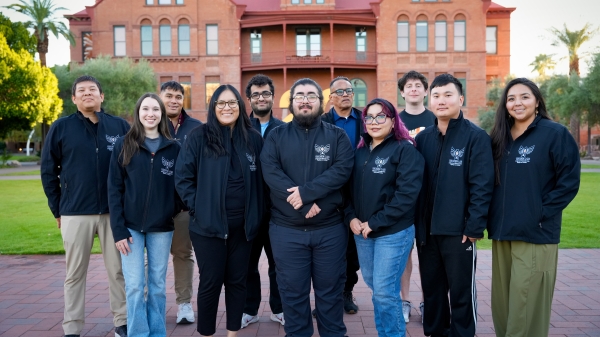Nearly 100 of the best ideas at Arizona State University will be showcased at Demo Day — a marketplace of the future that will pitch everything from a customizable bra to an app for parking spaces.
The ASU-affiliated entrepreneurs will compete for more than $250,000 in funding and support at the event, which will be held Friday, Dec. 1, at SkySong in Scottsdale. All of the participants are part of Venture Devils, a program in the Office of Entrepreneurship + Innovation at ASU. Venture Devils provides space, mentorship and access to funding to entrepreneurs who are ASU students, alumni, faculty, staff or community members.
The competitors include some businesses that have been developed over several years, including 33 Buckets, a nonprofit that provides clean water in developing countries and was featured in an ASU commercial during the Super Bowl, and Humanity X, which developed a technology to detect people in crisis on social media. Others are newer, such as Charity Auction Trades, a platform for nonprofits to raise money.
Mona Dixon, who has bachelor's and master's degrees from ASU, launched Charity Auction Trades earlier this year after working as a special-events coordinator for a nonprofit group.
“I was always having to solicit auction items for charity galas, and one thing I found was that the items that sold for the most money were out-of-town trips and experiences,” she said.
But most donors will only give locally. She then called nonprofits in every state and found out they had the same issue. So she came up with the idea of creating a platform for nonprofits to trade their donations and increase their value.
“So that 'staycation' package you traded with Arizona now becomes a vacation package for your audience and raises more money,” said Dixon, who's now working with her team on finalizing their financials and refining their pitch.
At Demo Day, the entrepreneurs will pitch to judges in one of six categories: sport, social, cyber/software, product, mix and protected technology. The event also will feature a presentation by the founders of Bravo, a tipping and payment app, who recently won a $150,000 investment on the TV show “Shark Tank.” The keynote address will be given by Keith Ryu, who graduated from ASU in 2014 and is now CEO of the Silicon Valley company OnboardIQ.
New this year is the Global Sport Venture Challenge, a competition for sports-related businesses that’s funded by the Global Sport Institute, a new research and inquiry unit that’s part of the Global Sport Alliance partnership between ASU and adidas.
Jeff Kunowski is an entrepreneur whose venture got a boost while he was a student at ASU. His business, Illumin8 Outdoor Media, which creates LED signage, won a $10,000 investment and office space in 2010.
Now he’s paying it forward, serving as the lead venture mentor for the Global Sport Venture Challenge.
“I’ve been through some of the ASU entrepreneurship programs, and they set me up for success early on,” he said. “So I wanted to create something with ASU to play off my strengths and bring people I knew to the table.”
Kunowski has been mentoring several startups during the fall semester while he has been helping to build the competition.
At Demo Day, 13 ventures will compete in the Global Sport Venture Challenge track, including Hoolest Performance Technologies, which has created way to reduce performance anxiety, and Muzzlesafe, which makes a gun-safety device. The top five teams will each win a $1,000 investment and will compete for the top prize of $5,000 in the spring.
“One of the main goals is to drive awareness that if you have a venture idea, you should think about the sports landscape, because it can go a long way in moving your product along,” said Kunowski, who has paused Illumin8 while working as a sales manager at Panasonic Enterprise Solutions. He graduated from ASU in 2011 with a degree in integrative studies focused on small business.
Kunowski said that sports arenas are like mini cities, with parking, retail, concessions, security, media and even health and wellness aspects.
“Sports are passion-driven. You have a large audience in a condensed area that can give you a sample of how people perceive your product,” he said.
Demo Day is a spotlight for ASU people who have taken the concept of entrepreneurship to the next level, according to Brent Sebold, executive director of venture development at Entrepreneurship + Innovation at ASU.
“Number three in the university’s eight design aspirations is ‘value entrepreneurship.’ That’s for everybody,” he said.
“As we reach people through the evangelism of entrepreneurship, we see a small subset of people who say that not only do they get it, but they are practicing it or want to practice it in earnest.”
Those people can apply to Venture Devils, which has upgraded its process this year to better ensure success. Applicants must now articulate their business plan into a one-page proposal, have a five-minute presentation and create some kind of online presence, such as a website or a Facebook page.
“That’s the real world,” Sebold said. “Nobody wants to read 10 or 50 pages.”
Venture Devils is now showcasing every project on its site, and each description will link to the business’s site.
“We’re investing university resources. We don’t want to say, ‘We have 250 ventures’ and half of them are half-baked ideas where one student said ‘I want to do this’ but didn’t take action,” Sebold said. Before this requirement, students frequently never took those concrete steps.
Students, alumni, staff, faculty and community members can apply to Venture Devils five times a year. The program is an umbrella for the various pitching competitions that are driven by the funding donors. For example, the Pakis Social Entrepreneurship Challenge, previously a standalone contest, is now in the “social” track of the Demo Day competition, with three teams to be awarded $7,500 each. The next Demo Day, April 27, 2018, will award additional funding and support to the finalist Venture Devils chosen on Dec. 1, including $20,000 to the Pakis winner in the “social” track.
“Previously, we were asking the same groups to apply to 10 different competitions 10 times a year,” Sebold said.
All Venture Devils get mentoring and can compete for space and funding, although most projects are far from the point where they need funding, he said.
“We provide the right startup with the right funding at the right time,” Sebold said.
Sebold said that ASU is unique in its entrepreneurial model, which, like any new venture, is constantly changing.
“It’s not a perfect science,” he said. “Our aim is to create a repeatable, scalable, developmental model for entrepreneurship within higher education.”
Attend a free information session on Venture Devils from noon to 1 p.m. Wednesday, Nov. 29, in Room 228 in the Memorial Union on the Tempe Campus. Click here for details. For details on Demo Day, click here.
More Science and technology

Cosmic clues: Metal-poor regions unveil potential method for galaxy growth
For decades, astronomers have analyzed data from space and ground telescopes to learn more about galaxies in the universe. Understanding how galaxies behave in metal-poor regions could play a crucial…

Indigenous geneticists build unprecedented research community at ASU
When Krystal Tsosie (Diné) was an undergraduate at Arizona State University, there were no Indigenous faculty she could look to in any science department. In 2022, after getting her PhD in genomics…

Pioneering professor of cultural evolution pens essays for leading academic journals
When Robert Boyd wrote his 1985 book “Culture and the Evolutionary Process,” cultural evolution was not considered a true scientific topic. But over the past half-century, human culture and cultural…
